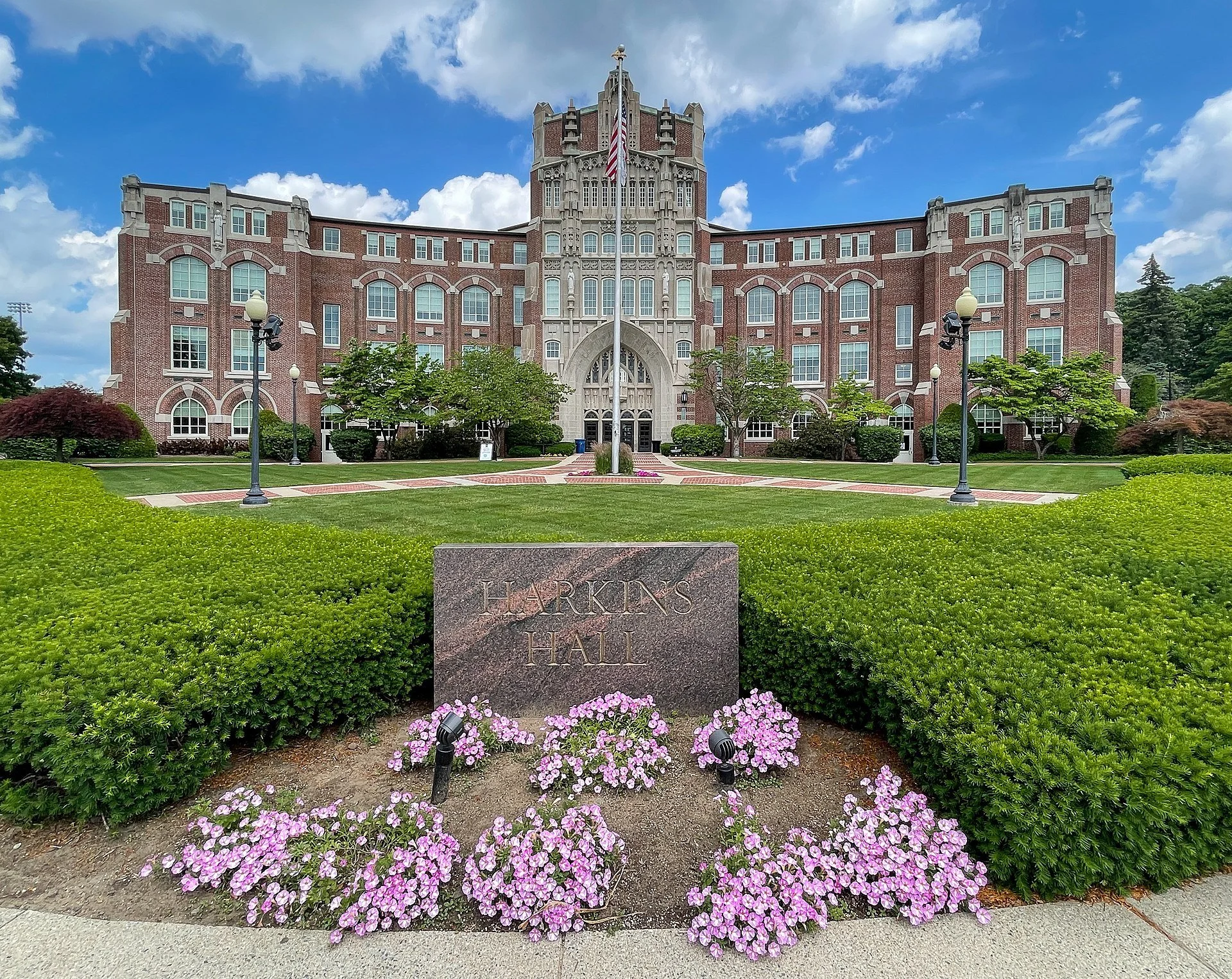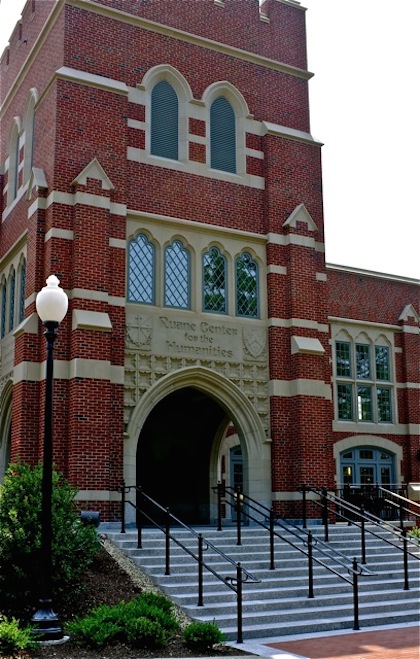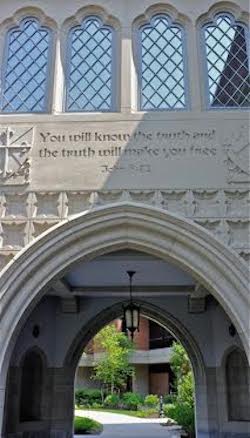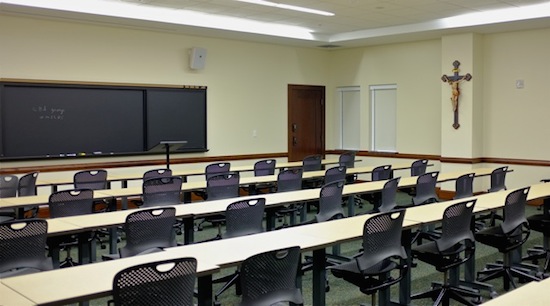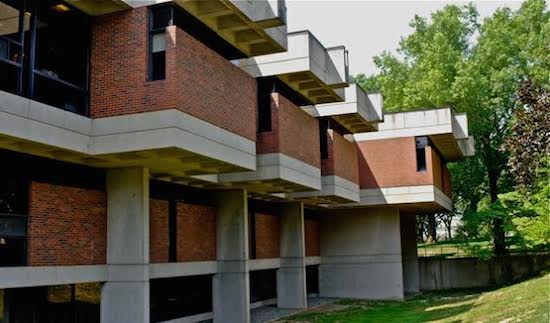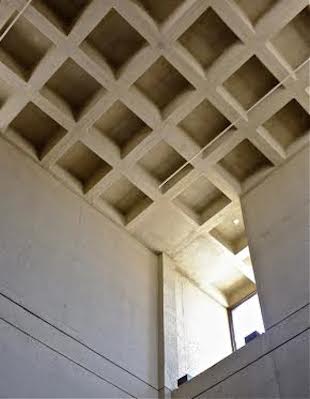
Then don't go there
Harkins Hall, at Providence College. The college’s first building, it was constructed in 1918—1919 in the Collegiate Gothic style then very popular on American campuses.
Adapted from Robert Whitcomb’s “Digital Diary,’’ in GoLocalProv.com
There’s considerable tension these days at Providence College, a Catholic institution founded in 1917, over the feeling of LGBTQ students and employees that PC’s administration doesn’t adequately respect them (or agree with them?).
The central problem, of course, is that Catholic theology doesn’t mesh well with the desires, actions and beliefs of these students and staff. One wonders, then, why they’re at PC, given the many other institutions they could attend. And after all, PC, let alone the Roman Catholic Church, has no obligation to change its views.
I taught at the college for several years and always found it was run in a kindly way. That was before most people had heard of “LGBTQ”. I’m waiting for a few more letters to be added in our identity-obsessed times.
Providence College’s new school
Harkins Hall (1919) at Providence College, designed by Matthew Sullivan in the Collegiate Gothic style
— Photo by Kenneth C. Zirkel
Edited from a New England Council (newenglandcouncil.com) report
BOSTON
“New England Council member Providence College has opened its fifth school, the School of Nursing and Health Sciences. This new school will achieve a goal set by PC’s president, the Rev. Kenneth Sicard, in his inaugural address, on Oct. 1, 2021.
“The new school will expand Providence College’s academic programs in a field that’s crucial to address the shortage of health-care workers in New England and the rest of the United States. In keeping with the college’s liberal-arts tradition, the curriculum included input from faculty from multiple disciplines. Community members wanted to ensure that the new cohort of students will think critically while studying health care to gain skills to help not only the physical but the mental and spiritual well-being of their future patients. The new school will allow students to step outside their normal course load to be able to study abroad, explore dual-language courses and complete immersive community experiences. PC will begin admission to the new school in the fall semester of 2023.
“Christopher Reilly, chairman of the college’s board of trustees, said, ‘These academic initiatives will enhance Providence College’s impact on society in ways that honor the institution’s mission and heritage. They will create exciting opportunities for our students, guided by our faculty, to prepare for lives of meaningful service in assistance to our neighbors and our communities.”’
John O. Harney: An early look at 2022’s college-commencement season in New England
BOSTON
From The New England Journal of Higher Education (NEJHE), a service of The New England Board of Higher Education (NEBHE.org)
Long before COVID changed everything, NEJHE and NEBHE’s Twitter channel kept a close eye on New England college commencements. “The annual spring descent on New England campuses of distinguished speakers, ranging from Nobel laureates to Pulitzer Prize winners to grassroots miracle-workers, offers a precious reminder of what makes New England higher education higher,” we bragged. “It is a lecture series without equal.”
In the past two pandemic years, we tracked a lot of postponements and virtual commencements on this beat, as well as Olin College of Engineering’s March 2020 “fauxmencement” ceremony right before coronavirus shut down the campus. Some medical schools at the time moved up graduation dates so graduates could join New England’s COVID-fighting health-care workforce. Dr. Anthony Fauci addressed graduates of the College of Holy Cross, his alma mater.
Going virtual meant hard times for some small New England communities where college-commencement days were crucial to local hospitality providers and the economy. Not to be confused with such larger commencement hosts as the Dunkin Donuts Center for Rhode Island College and Providence College and TD Garden for Northeastern University (switched to Fenway Park during COVID).
This year, as we all hope the pandemic is easing, some New England colleges plan to celebrate not only the class of 2022, but also the classes of 2020 and 2021—for the most part, in person.
Many years, we would pay special attention to the first few announcements of the season. When there was a season. Generally it was spring in the old days. But today’s nontraditional student pursing higher ed on a nontraditional academic calendar might just as easily graduate in January … or any other time for the matter.
As with other stubborn aspects of higher ed, the richest institutions often announced the heavy hitters, though sleepers at quieter places add special value too (think Paul Krugman at Bard College at Simon’s Rock or Rue Mapp at Unity College).
Harvard University, for its part, announced that the principal speaker at its 369th commencement, on May 26, would be New Zealand Prime Minister Jacinda Ardern. Not a bad pick. Ardern has been lauded for her work on climate change and gender equality and, lately on how she has guided New Zealand through COVID. Harvard noted she will be “the 17th sitting world leader to deliver the address.”
John O. Harney is executive editor of The New England Journal of Higher Education.
Boston negativity 'sucks'
Rick Pitino in a press conference for the 2013 Final Four when he was head coach at the University of Louisville
“The only thing we can do is work hard, and all the negativity that’s in this town {Boston) sucks.’’
— Rick Pitino (born 1952), basketball coach at colleges (including Providence College) and the NBA (including the New York Knicks and the Boston Celtics.
The Celtics hired him as head coach in 1997. He resigned in 2001, after a 102-146 record.
Western Civ at Providence College
From Robert Whitcomb's Nov. 10 "Digital Diary'' in GoLocal24.
Prof. Anthony Esolen, who teaches Renaissance English Literature and the Development of Western Civilization at Providence College, a Catholic institution, has questioned the college being a "committedly and forthrightly Catholic school" and has been denounced for his remarks.
"Is not diversity, as currently promoted, at odds with the foundational diversity built into the nature of the human race, the diversity of male and female, to be resolved most dynamically and creatively in the union of man and woman in marriage?" wrote Mr. Esolen for Crisis Magazine. "Is not that same call for diversity, when Catholics are doing the calling, a surrender of the Church to a political movement which is, for all its talk, a push for homogeneity, so that all the world will look not like the many-cultured Church, but rather like the monotone non-culture of western cities that have lost their faith in the transcendent and unifying God?’’
Inevitably, he was denounced for his remarks by some PC faculty members. What they should have criticized – maybe -- is the seeming opaqueness of some of his phrasing. In any event, a faculty letter against him reads, in part:
“As PC Faculty, we pledge to break the silence around systemic racism and discrimination on Providence College’s campus. While we vigorously support free expression, recent publications on the part of PC faculty have involved racist, xenophobic, misogynist, homophobic, and religiously chauvinist statements. The use of this type of language by people with power over students runs counter to the Catholic mission of Providence College, which aims ‘to reflect the rich diversity’ of our world, and ‘extend a loving embrace to all."’
“As a diverse coalition of students have consistently highlighted, such statements are part of a broader pattern of racism, sexism and other forms of hate that are all too common not only on campus, but in the broader public culture. As professors who care deeply about the well being, safety, and growth of our students, we are committed to combating racism and overcoming the hostile learning environment for too many of our students, while creating spaces where all of our students can engage in meaningful ways.’’
Oh, come on! The statement, which sounds like a call for censorship by the college or at least self-censorship by the likes of Mr. Esolen, makes mild-mannered PC sound like a 24/7 Ku Klux Klan meeting!
Note such empty words as “meaningful’’ and “diversity’’ (of what?). And of course they treat the poor little lambkins students as if they’re far too fragile to hear an opinion that might lower their comfort levels or make them reconsider the received wisdom that now rules on most American campuses. And, as usual in such cases, they accuse Professor Esolen of writing things he never wrote. Their rhetoric recalls the rhetorical dreck of dictatorships such as Stalin’s Soviet Union in which “class enemies’’ are singled out in language contorted to fit the political lies needed to help the likes of Stalin stay in power.
The response from the Rev. Brian Shanley, PC’s president, was the usual stuff you get from college presidents these days, many of whom lack intellectual and cultural self-confidence:
Father Shanley wrote:
“He {Mr. Esolen} certainly does not speak for me, my administration, and for many others at Providence College who understand and value diversity in a very different sense from him.’’
So what precisely does “diversity’’ mean to the PC administration? Is it just about skin color, varieties of sexual desire, surname, ethnic cuisine….? Are intellectual and political diversity also encouraged?
Meanwhile, let’s put in a good word for Western Civilization, which Professor Esolen reveres and his presumed preference for which over other cultures is presented as making him an enemy of “diversity’’.
It’s a civilization that has permitted students and faculty at colleges in the West to speak freely and pursue their dreams as in no other place in the world. Refugees want to flee to the West because of its freedom of expression and of inquiry, and how it protects what Jefferson memorably called “the pursuit of happiness.’’ Those freedoms are key drivers in creating the prosperity that also leads people to flee to the West. If it is so awful, why is the flight one way? And where are things more “diverse’’ than in nations within what many of usstill call Western Civilization?
The complainants can easily resolve their issues by transferring to a non-Catholic college. Since we’re in Western Civilization (or what’s left of it), they have the freedom to move.
Green and black: 'Nature, art and humanity'
''Mountain Temple Skyscraper'' (asphalt, mirror-tinted Plexiglass, plastic and topiary installation) by Robert Andrade, in his show "To Move an Obelisk,'' at the Hunt-Cavanagh Gallery at Providence College.
The gallery notes that this show “features sculpture that intertwines modern art, aspects of public space and Modernist architecture. His works consist of unique construction materials to create life-like sculptures of images in nature.’’ The image above, despite its eccentric mix of media, “has a sense of realism from both up close and afar…. The sculptures are seemingly built into the exhibition space, giving the viewer a new sense of perspective on how nature, art and humanity intertwine.’’
Mr. Andrade also “notes his interest in certain political structures by alluding to the town square in which a democratic public would gather to discuss, debate or protest, among other activities. ‘To Move an Obelisk’ speaks to the ways in which humanity interacts with nature and the importance of those two forces working together.’’
William Morgan: Faux Gothic at Providence College
Commentary and photos by WILLIAM MORGAN "I feel to the depths of my being that this emblematic new building is not only a step for Providence College, but for our country," David McCullough declared last October at the dedication of the Ruane Center for the Humanities at the 90-year-old Dominican school in the Rhode Island capital. Despite such noble sentiments from everyone's favorite historian and commencement speaker, the new home of P.C.'s Western Civilization program actually portends a journey into a Disney-fied architectural wilderness.
The buttresses and arches of the Ruane Center entrance tower are not structural.
As a style, Collegiate Gothic created some memorable American campus architecture. Ruane Hall, however, falls leagues short of a credible re-creation of either the look or the spirit of Oxford and Cambridge that infused the Princetons, Yales, and Michigans at the turn of 20th Century. That Gilded Age offered architects thoroughly conversant with the past, backed up by skilled craftsmen. What we have today at Providence College is an uninspired piece of real estate wrapped with a thin veneer of brick and a few pointy details. This is the same sort of Potemkin village found in upscale shopping malls and themed suburban restaurants.
Biblical "truth" perhaps, but the Ruane Center's stage-set Gothic is something of a lie. There is no carving whatsoever, just stamped details.
The pasticheurs of this paper-thin storybook castle are the S/L/A/M Collaborative and the Boston firm of Sullivan Buckingham Architects. S/L/A/M is a large, multi-city firm that cranks out instant history for both private colleges and state universities ("Not what kind of building do you need, it's what kind of institution do you want to be"). Sullivan Buckingham, designers of the chapel and an art center at P.C., was founded to provide "traditional" institutional buildings. "Our buildings in various styles," the firm claims, "Classical, Romanesque, and Gothic, are not lifeless copies; they are historically correct." Yet, beyond the battlemented square tower, the classrooms and offices are depressingly yesteryear's high school. The aggressively bland interior is a far cry from the Rugby of Tom Brown's School Days.
The classrooms in the Ruane Humanities Center are more bond-starved public high school than Gothic-inspired halls of learning.
In noting that the Ruane Center stands next to a "Brutalist" library, Sullivan Buckingham naively state that by employing brick and by matching the height of the library they were able to "achieve détente between the warring styles." The very term Brutalism is a bugbear to putative traditionalists, deployed as a weapon with which to excoriate a significant modern movement that they misunderstand. The neighboring Phillips Library–a superb example of Brutalism–is a 1969 work by Sasaki, Dawson and Demay. Long known simply as Sasaki Associates, the Watertown, Massachusetts firm was founded by Hideo Sasaki, one of the great modern landscape architects.
Phillips Library by Sasaki, Dawson and Demay is similar to other bold buildings the firm did at the Universities of Rochester, Louisville and Virginia.
Brutalism is not to everyone's taste, but it deserves more respect than simply being dismissed because of an unfortunate label. This antidote to the slick glass and steel corporate style of the 1950s created some notable rugged concrete architecture, such as the Boston City Hall and the architecture school at Yale.
In seeking historical legitimacy by grasping at a very thin thread back to the Gothic cathedrals, the Dominican college ignores an exceptionally tectonic work. Sasaki's library is a not a decorated box, but a vigorous composition with the constructional logic of true Gothic. One can "read" the elements with which it was constructed, while the brick is honestly expressed here as a curtain wall supported by the reinforced concrete skeleton.
Instead of conjuring up a cheaply constructed faux medievalism, Providence College might recognize that it is the steward of an unsung masterpiece, worthy of contemporaries such Louis Kahn and Paul Rudolph. Thus the irony of the quote by the greatest American Gothicist, Ralph Adams Cram, with which Sullivan Buckingham open their website:
A building must look like what it is, express visibly the energy that informs it, and declare its spiritual and intellectual lineage through its architectural vesture.
This is not a description of the flaccid Ruane Center, but it does fit the library.
Although the interior of the Phillips Library has undergone a questionable decorative overlay of American craftsman detail, one can still experience the evocative raw concrete structural elements, such as these waffle coffers.


